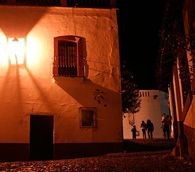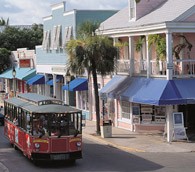Tag: Ernest Hemingway
A Not-So-Literary Tour of South-Central Mexico
by Peter Ferry | 06.27.15 | 4:11 PM ET
Peter Ferry made the trip based on a story he'd heard about Hemingway's Lady Brett Ashley, but in Taxco, nothing was quite what it seemed.
Travel TV Movie Watch: ‘Hemingway & Gellhorn’
by Jim Benning | 04.24.12 | 7:43 PM ET
For those of you who just can’t get enough Ernest Hemingway in your life (and, really, love him or hate him, who can ever get enough?): HBO is behind a new film about the romance between Papa and Martha Gellhorn. It premieres on HBO Monday, May 28, and stars Clive Owen and Nicole Kidman. And hey, isn’t that Metallica’s Lars Ulrich in the trailer, talking about people heading to Spain? Why yes (thanks, IMDb).
Cue Ulrich’s anthem to landmine wounds?
Russell Banks, Ernest Hemingway and Masculinity in America
by Jim Benning | 02.24.12 | 12:33 PM ET
The New York Review of Books explores Russell Banks’ novels and touches on Ernest Hemingway’s legacy in American letters.
When it comes to the anxiety of influence, American women writers seem to have an easy relation to their gentler and more urbane literary ancestresses; but men writing in America have to contend with the shade of Hemingway, and the longstanding tradition of manliness he tried to represent. They may reject that tradition but they can’t ignore it, though Henry James may have been trying to by making himself into an Englishman. Most of the ongoing mining of Ernest Hemingway’s character, sexuality, and personal history arises from our sense that he embodied the paradoxes and conflicts in masculinity as Americans have constructed it. Was he a bully or a baby, brave or cowardly, gay or straight, tough or weak?
That “shade of Hemingway” has colored American travel writing as much as any other genre, of course. The article is available online but only subscribers can read the piece in its entirety.
R.I.P. George Whitman, Shakespeare & Company Owner
by Jim Benning | 12.15.11 | 12:25 PM ET
It’s hard to imagine Paris without Shakespeare & Company, and George Whitman, who died yesterday at the age of 98, owned the famed Left Bank bookstore for years.
He took its name from the original shop owned by Sylvia Beach.
“For decades,” the New York Times notes, “Mr. Whitman provided food and makeshift beds to young aspiring novelists or writing nomads, often letting them spend a night, a week, or even months living among the crowded shelves and alcoves.”
Travel writer Erin Byrne profiled Whitman several years ago, noting that he had “fashioned a life for himself that brings together the two things he loves most in all the world, books and people. It is this combination that makes him tick. Old age without loneliness is unusual; George always has a house full of friends. Fragility without weakness is seldom seen; this man is thin and frail, but his presence is noble.”
His daughter, Sylvia, discusses her father and the store’s history in this terrific video:
Pilar and Ernest Hemingway’s Prose
by Jim Benning | 10.03.11 | 12:54 PM ET
Ernest Hemingway bought his beloved boat, Pilar, in a shipyard in Brooklyn in 1934. Could the ensuing time he spent on the boat have altered his writing style? At least one writer thinks so. Paul Hendrickson is the author of the new book, Hemingway’s Boat: Everything He Loved in Life, and Lost, 1934-1961.
NPR’s Rachel Martin interviewed Hendrickson and asked, “What did he [Hemingway] want from the boat?”
Hendrickson had an intriguing reply:
I think he wanted escape. I think he wanted to get away from shore. In fact, I make the case in this book that Pilar helped broaden out, so to speak, his prose line. When you say Ernest Hemingway, what do you think? You think of these simple declarative sentences, these magical and yet very short sentences, free of the subordinate clause. What happens, Rachel, from the mid-‘30s onward, the Ernest Hemingway sentence gets longer and longer and longer. Why is this? I like to make a case that aboard Pilar, getting away from shore, getting away from the sniping critics, getting away from all the petty little literary games, he can get out there in the Gulf Stream and he can free himself in some way.
Cross-posted from JimBenning.Net.
If Hemingway Were Alive, Which European City Would He Go To?
by Michael Yessis | 07.14.11 | 11:05 AM ET
Eight writers and academics make their pitches in the New York Times’ Room for Debate. The leading cities? London and Berlin.
Josef Joffe, the editor of Die Zeit in Hamburg, picks London:
By way of elimination, it is London—Europe’s global city, in the way New York, L.A. and Mountain View are global cities. London has the money (coming mainly from financial services). It is a city of a myriad nationality. It leaves you alone even as it offers a thousand points of distraction. Though no longer the capital of an empire, London draws the best and the brightest from all over the world—which highlights another critical condition: language.
When Paris was queen in the 18th and 19th century, every educated person in Europe spoke French, a trait that lasted into the 20th century. Today, everybody speaks English, or at least Bad English, which is the world’s fastest growing language. But who now has a command of German, let alone Dutch or Italian? If the rest of the world ever takes to Chinese as it has taken to English, Shanghai might join the roster. But the 3,000 signs of Chinese are a bit harder to master than the 26 letters of the English alphabet.
Writer and journalist Slavenka Drakulic makes a case for Berlin:
In more than two decades after the collapse of Communism, a flood of eastern Germans as well as citizens from other eastern European countries (refugees from the Balkan wars, Russian Jews), young Americans and other Westerners have moved to Berlin. Together with the old “guest workers”—Turks from Kreutzberg—they turned the city into an exciting mixture of people of which real Berliners are but a few.
But this alone would not be enough to make Berlin the center of cultural life. So many artists flock to Berlin because living there is cheaper than living in any other big city in Europe. It also helps that Germany is one of the few countries left that cares about the arts and sponsors culture through various institutions, grants, awards, festivals and conferences. Imagine, writers there get paid for their readings!
What We Loved This Week: Jonathan Raban, Ricardo Arjona and Ernest Hemingway, Humor Writer
by World Hum | 08.27.10 | 5:18 PM ET
Eva Holland
“At Sea,” Jonathan Raban’s ode to the simultaneous isolation and civility of the seagoing life. It’s a 1996 magazine story that I came across in The Best of Outside—here’s a favorite section:
In the society of the sea, it is the duty of every member to keep his distance from all the others. To be alone is to be safe. It’s no coincidence that those two most English of attitudes, being “standoffish” and keeping aloof,” are nautical terms that have long since passed into the general currency of the language. Standing off is what a ship does to avoid the dangers of the coast; aloof is a-luff, or luffing your sails, head to wind, to stay clear of another vessel. The jargon of the sea is full of nouns and verbs to describe the multitude of ways in which a ship can keep itself to itself.
Front Row at Pamplona’s Running of the Bulls
by Rick Steves | 07.27.10 | 2:09 PM ET
On watching the mad, red-and-white scramble at Spain's legendary Festival of San Fermín
Bullfighting, Hemingway and the ‘Seduction of Death’
by Jim Benning | 07.09.10 | 12:17 PM ET
Is bullfighting an important tradition that should be preserved? Is it so cruel it should be boycotted and banned? And why was Hemingway so taken with it?
In a fine TNR review of Bullfighting: A Troubled History, Ben Wallace-Wells offers a brief history of the sport and summarizes the perspective of author Elisabeth Hardouin-Fugier.
She falls squarely in the reformist camp, and her history argues that the sport seduced artists, who glamorized and abstracted a cruel and ugly pursuit into something that bore little resemblance to bullfighting itself. On the matter of Hemingway she is not subtle. “Hemingway is an emblematic representative of the aficionados who were in love with death,” she writes.
As I’ve noted before, I’ve had my own brushes with death in the bullring. (Via AL Daily)
In Celebration of the Daiquiri
by Eva Holland | 06.26.09 | 11:36 AM ET
It’s been 100 years since the daiquiri—now practically the official drink of the warm-weather getaway—first made its way from Cuba to the United States. The Daily Beast takes a look back at its origins and many more modern variations, including the El Floridita daiquiri, reportedly Hemingway’s favorite.
The Book Bench: ‘Let’s all Move to Berlin’
by Eva Holland | 05.04.09 | 3:01 PM ET
I’ve had a longtime fascination with the Parisian expat writers of the 1920s. Books like “A Moveable Feast” or “That Summer in Paris” never fail to make me wish I was sitting in a Left Bank cafe, making a cup of coffee last for hours while I wrestle with a short story or pause to chat with other struggling writers who’ve wandered by.
Of course, Paris is hardly the place for impoverished creative types anymore, but—say the New Yorker’s Book Bench bloggers—there’s a viable European alternative if I ever decide to attempt a modern-day recreation of my Hemingway daydreams: Berlin.
Anthony Hopkins Takes Lead in Upcoming Hemingway Movie
by Eva Holland | 03.26.09 | 10:21 AM ET
The veteran, Oscar-winning actor has been cast as Ernest Hemingway in an upcoming indie titled “Hemingway and Fuentes,” Hollywood.com reports. Andy Garcia—who will also co-write and direct the movie—will play Gregorio Fuentes, a friend of Hemingway’s in the author’s final years who is said to be the real-life inspiration for Santiago of The Old Man and the Sea fame.
As always when a beloved literary figure or book is involved in a Hollywood production, my first reaction to this news is gut-clenching anxiety. Hemingway’s stories and novels—not to mention his Paris memoir, “A Moveable Feast”—have done as much as the “official” travel literature canon to make me curious about the world over the years, and unfortunately the movie industry has let book-lovers down too many times. But on the other hand, Anthony Hopkins is a fabulous actor who makes smart script choices more often than not, so I suppose there’s reason for hope.
What do you think of Hopkins as Hemingway? (Via Alltop)
Robert Louis Stevenson: Internet-Bound
by Eva Holland | 01.15.09 | 1:49 PM ET
A new website is in the works for the “Treasure Island” author, in an apparent effort to revive his fading legacy. (As Book Bench blogger Katherine Ryder puts it, “he’s been left out of various editions of the Norton Anthology of English Literature; worse, “Treasure Island” has been adapted by Hollywood so many times, even Kermit the Frog has a version.”) When it comes online in 2010, the site will make Stevenson the latest travel-esque literary heavyweight—after George Orwell and Ernest Hemingway—to find a new home in cyberspace.
While we’re waiting, Ryder recommends reading Stevenson’s An Apology for Idlers. “He’ll remind you of a vision of life that our teachers warned against,” she writes, “that aimless days are just as important as work days, that staring out the window is also learning, that unadulterated bliss is found with your feet up ... He may even convince you to take a vacation, or at least demand more of one.”
The Songlines of Key West: The Conch Republic, Unscripted
by Bill Belleville | 01.09.09 | 9:35 AM ET
In a three-part series, Bill Belleville burrows deep into the spirit of the mythic island. Part three: Into the mystery of the twilight.
The Songlines of Key West: Doing the Duval Crawl
by Bill Belleville | 01.07.09 | 10:28 AM ET
In a three-part series, Bill Belleville burrows deep into the spirit of the mythic island.
Cuba’s Hemingway Museum Goes Digital
by Eva Holland | 01.05.09 | 2:58 PM ET
American Hemingway scholars don’t have to wait for a lifting of the Cuba travel embargo to gain more insight into the writer’s work: The island’s Hemingway Museum is digitizing large chunks of its invaluable collection, reports the Cuban News Agency.
When the author died in 1961, he left behind thousands of pages of manuscripts, maps, letters and photos at his farm outside Havana—all of which were apparently donated to the newly minted Cuban government by his wife. Government preservationists have already digitally reproduced more than 3,000 of the roughly 15,000 documents in the bequest.
(Via The Book Bench)
I Still Don’t Know For Whom the Bell Tolls
by Doug Mack | 11.29.06 | 7:49 AM ET
 Photo of Ernest Hemingway's Key West house by pumpkinoodle, via Flickr.
Photo of Ernest Hemingway's Key West house by pumpkinoodle, via Flickr. In Florida's Key West, land of tropical cocktails, Doug Mack went to Ernest Hemingway's house looking for inspiration. He found some, but not the kind he hoped.
Bullfighting School: ¿Quién es Más Macho?
by Jim Benning | 03.13.06 | 12:50 PM ET
I don’t talk about this much because, frankly, it just intimidates people, as it should. But back in 1998, when I was but a young magazine freelancer with a dog-eared copy of Hemingway’s “The Sun Also Rises” on my bookshelf, I enrolled in bullfighting school. The California Academy of Tauromaquia in San Diego, to be specific. That’s me in the photos. It was for a story for Men’s Fitness magazine.
I studied the art of bullfighting for several weeks, learning the ins and outs of cape-handling, among other essentials. For homework, I studied episodes of the TV show “When Animals Attack.” And then, wearing the traditional white shirt and cap of a bullfighting student, I stepped into a stone bullring in Mexico under a hot desert sun (actually, it was rather cool, but “hot” sounds more unforgiving; stick with me here), and went mano a mano with a snarling, charging 400-pound heifer. I graduated with honors.
Before any of you send angry e-mails: Not only did I not harm the animal, but at the time, I was a vegetarian who wouldn’t go within 10 feet of a Big Mac, so send your notes elsewhere. But I digress. I bring this up now because Gadling just pointed out a recent New York Times story in which the writer attended the same bullfighting school and faced a 300-pound heifer.
Now, I know what you’re thinking: Three hundred pounds? That’s it?
Exactly. That’s the first thought that ran through my mind.
Back in the day, if you wanted to prove yourself in the ring and deliver a meaty story to your editors, you made sure you faced at least 350 pounds of lumbering beef. Know what I’m saying? And honestly, if you were an editor worth your salt, you wouldn’t print a bullfighting story by a writer who faced anything close to 300 pounds. At the New York Times, you’re just giving more ammunition to those in Red America who claim the liberal media elite are out of touch. Don’t you editors know your heifers? Get back in touch. We need you. No bull. Okay, a little bull.
As for the California Academy of Tauromaquia, it offers an excellent bullfighting education, and I’d recommend it to anyone interested in learning the basics. And really, shouldn’t we all know at least the basics? No? Okay.
- « Prev Page
- Next Page »






